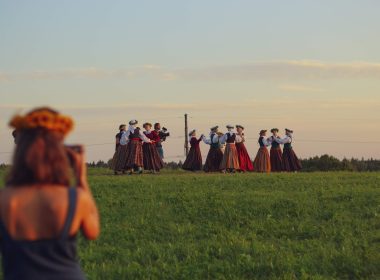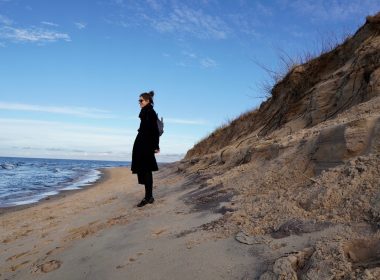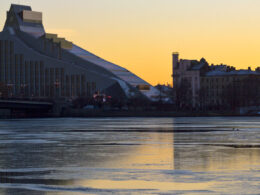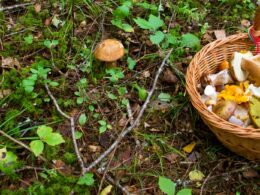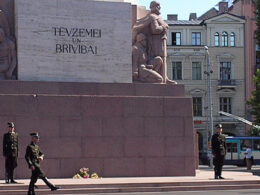I fear deep water but still find comfort by the sea and enjoy frollicking in the shallow bits. On the day of my husband’s and my most epic fight to date, I knew and felt that I had to go to the beach to get over it, and this was long before it was warm enough to swim. I just walked and let the wind carry away what needed to be left behind. It worked! Before and since then, we’ve been on many beach walks together. Every once in a while you just feel its pull somehow.
So, to me, the sea is somewhere I go for clarity, rest and rejuvenation. For others, it’s a livelihood. The Latvian coastline and its historical fishing villages are a vivid illustration of these differences and the societal and economic shifts that the land has witnessed. A seasonal tourism industry has flourished alongside the fishing industry whose story can be read from both the net-draped traditional timber dwellings and industrial infrastructure.
Folk songs and customs speak of the significance of the sea to our ancestors. Today, we also celebrate it at festivals like Jūras and Zvejnieku svētki (Sea and Fishermens’ fairs) – a much more recent tradition than one might think, born in the 1930s. Nēģu svētki (Lamprey fairs) are also a thing!
In my endless curiosity, I asked around to find out what other locals seek and find by and in the sea and what it means to them, as well as if any songs, books, films or pieces of music bring up feelings of or associations with the sea. Here’s what they answered!
Anita Karpinska, graphic designer and artist
Whenever I live somewhere for a while, the sea has to be close or quick to reach. It’s where you can finally widen your physical worldview – the horizon is so vast and constant, it’s calming. And, if you take the time to reflect, the sea can also expand your horizons on a spiritual level.
I really enjoy multiple day hikes along the sea. They give me a sense of discovery. I’ve done many long walks along the coast in several countries because I feel like if I just go that little bit further, I’ll see if anything interesting lies ahead. In that way, you can walk far and make plenty of interesting discoveries.
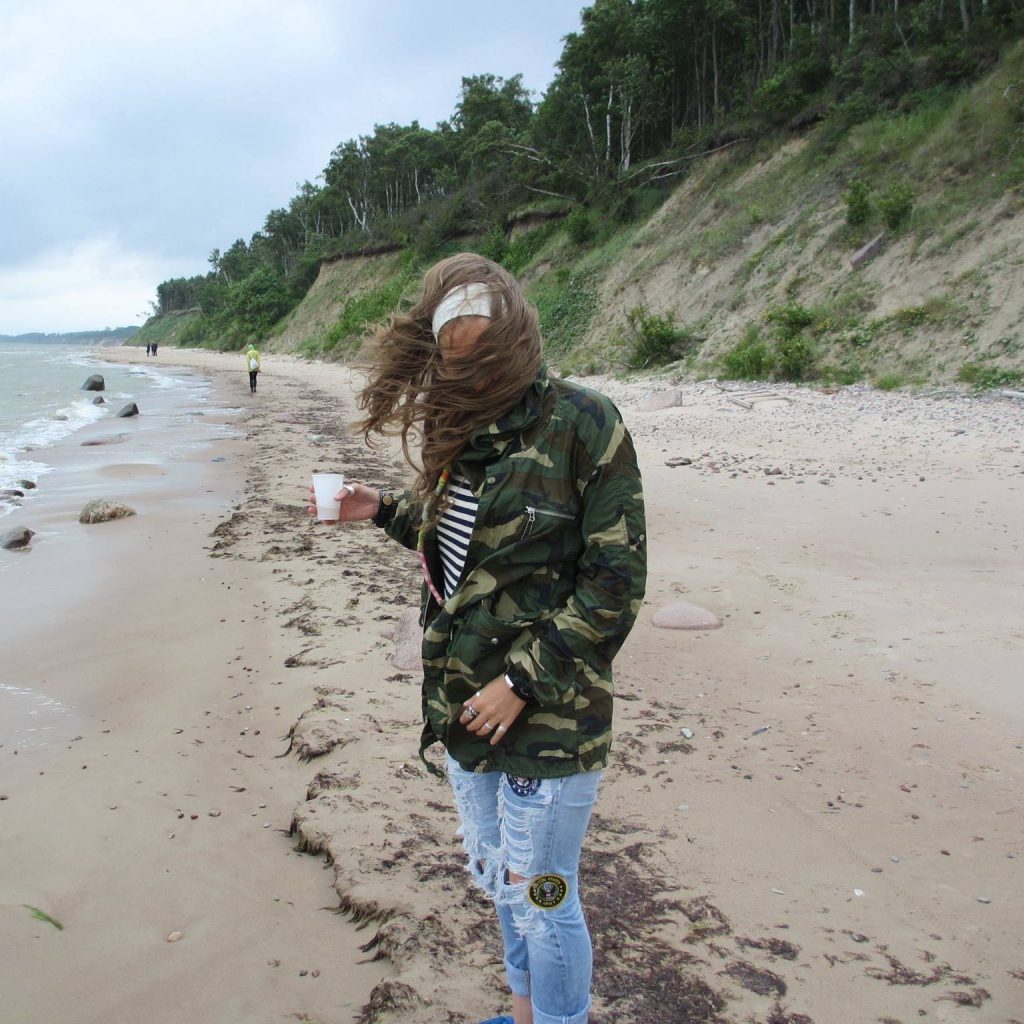
I always like to turn left when I get to the beach because it seems more promising. I’ve discovered everything of interest that way. I just get this indescribable feeling that that’s where I need to go. In Spain, near Cadiz, I ended up discovering some ancient Roman ruins and a Moorish cave hidden beyond a totally wild beach and army base. Neither of them were mentioned in any guidebooks. I just had this overpowering feeling that I needed to walk in that direction, a little more to the left and just a bit further.
In Italy, that’s how I came across a village I’d once seen in a photo. I didn’t know which part of Italy it was in but felt like I just needed to turn left and walk along the sea for a few hours and see what I’d find. In Portugal too, I’ve found places in that same way. I tend to film a lot of my adventures on camera and drone, which gives me additional motivation.
Ancient cultures and history fascinate me. Egypt, Iran and Iraq are captivating. One day, I looked at the map and realised that if I went down to the beach in Jūrmala, for example, and turned left, then I’d eventually reach all the countries that have appealed to me as far as the African continent. Since I’ve walked the Camino del Norte, I feel like maybe I should just go do it!
Anita’s artistic assocation with the sea is Thirst by the Latvian artist Voldemārs Johansons.
“The first time I ever saw an ocean – the Atlantic Ocean – was on a stormy night. You could barely even see it. It was only when the waves would break that I became aware of the sheer size of them. Very impressive and immortal! Like dinosaurs – ancient, huge and roaring,” Anita adds.
Annija, founder of the Steel Storm design brand and resident of Liepāja
As someone born in Riga, I remember the packed trains to Jūrmala, the crowded beaches and relatively calm sea. Now, living in Liepāja, the sea means something completely different to me than it did in my childhood.
The sea is always beside me. Living close to it, you know that you’ll always have somewhere to go to feel peace and freedom, even on the days when it’s wild, because it’s the open sea after all.
I go to the sea to restore myself, be with myself, find energy and inspiration, feel peace and freedom. What I take from the experience depends on both me and the sea on that particular day. Even if it’s rough and choppy, I find a certain peace in the sea.
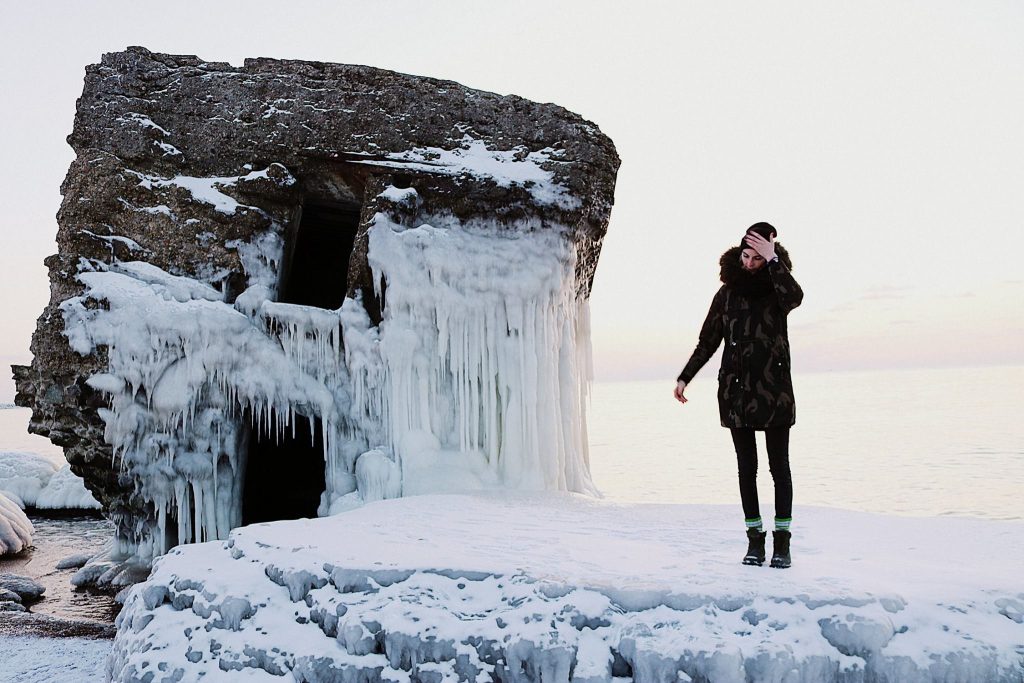
I find freedom on the empty beaches in winter or more distant beaches where it’s just me and the mighty sea. The intense winds and waves tend to give me an energy boost and the inspiration to get things done – that’s when the winds have properly battered you. Crowded beaches and happy beachgoers do the same.
The sea isn’t just water to me. It’s life, stones, amber, seaweed, seashells, fish, bits of wood, sand, dunes etc. One of my favourite things to do when I’m at a rocky beach is finding “lucky pebbles” (pebbles with a hole in them) and other pretty stones that you can use to build pyramids or create other art.
Swimming is most enjoyable on warm summer mornings when few people are awake yet, and at sunset when you get to bid the sun farewell.
In winter, it’s a place of magical views, just like Narnia.
Annija contributed two songs that she associates with the sea. Ziemeļmeita is also one of 18 Iconic Songs to Help You Understand Latvia and Latvians.
Vladislava, resident of Jūrmala
To me, the sea means a sense of home.
It’s a place for both spiritual and physical rest, somewhere for making asks and giving gratitude, freeing yourself of burdens, and self-talk.
It is sunrises and sunsets, waves and frozen legs, an overheated body on a hot day, and the call of the seagulls. It is a tomato you bring with you to snack on after the swim, and cherries to enjoy with a good book. It is fog and the silence of winter. The sea is a treasure.
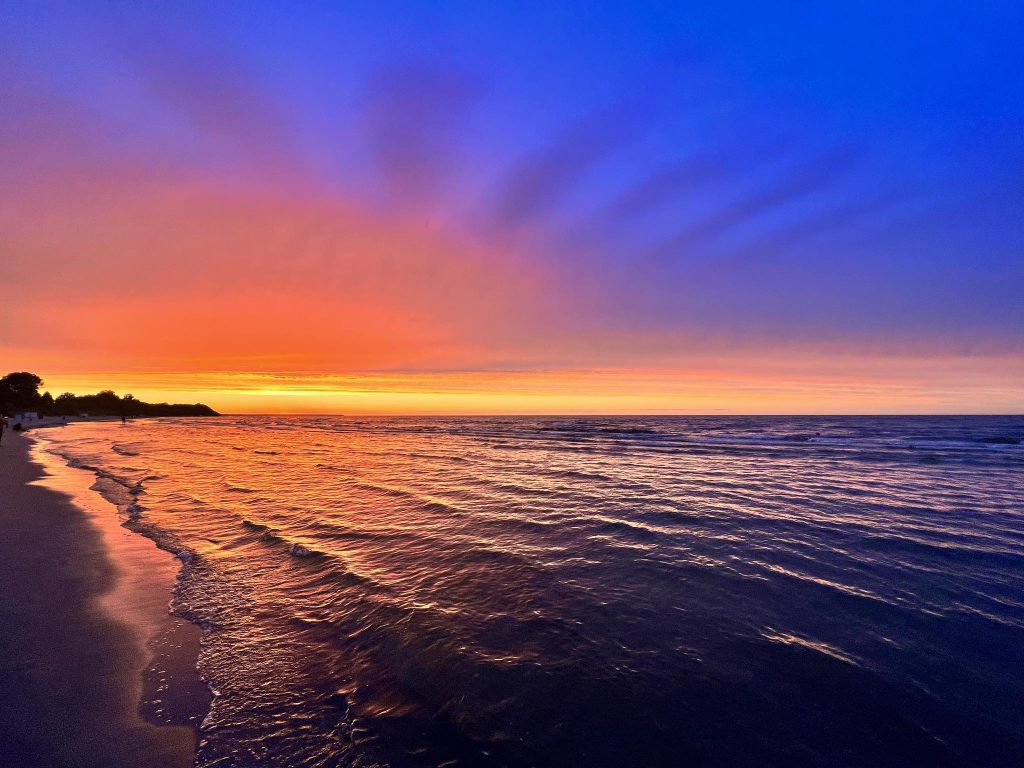
I go to the sea seeking peace and energy. It enables me to restore my inner strength. In summer, I go for daily swims. Sometimes, I observe the sea living its life and pick up on answers to my questions.
Vladislava mentions this song and one particular line in the lyrics: “Un dzintara jūra mūsu laimei te šalc”(And the amber sea rustles here for our joy).
Alexandra, self-proclaimed thalassophile
I’ve had a special relationship with the sea since early childhood. While everyone would be spending time in the yard, I’d be waiting for my father to finish work so that we could go to the beach.
On Tuesday and Thursday evenings, he played beach volleyball, as well as spending weekends by the net, and I was his most supportive crowd. My friends were there as well, hiding in the sand, dunes and woods, and waiting for the woman with sun-kissed skin to pass by – does anyone else remember this famous lady who would walk along the shore with a trolley selling ice cream? Plombīrs was my favourite.
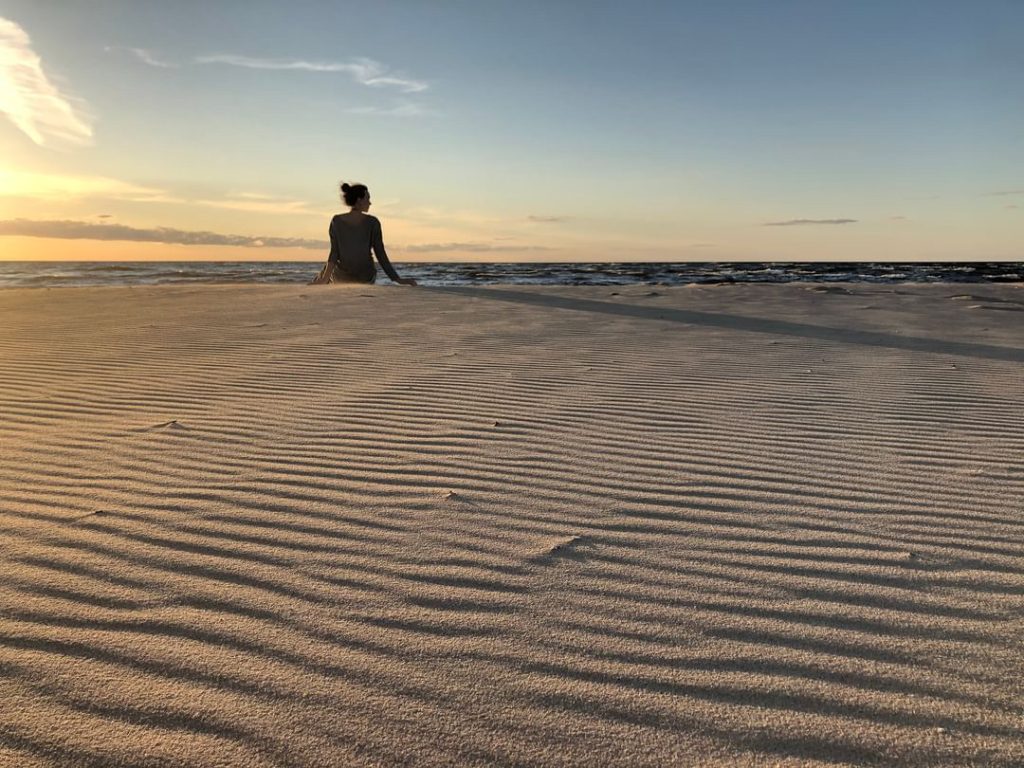
Then, different times came – times of self-awareness and self-reflecting – youth, when you think of no one but yourself and don’t understand the meaning of love yet, or whether it even exists. Those times were best spent by the sea, thinking and loving silently. Silence is what the sea accepts and is best at providing. You can shout, you can cry, but being silent beside the sea is a pure gift of nature. As you are silent, it listens, and feels at times like it is taking everything away, all your self-reflections, self-torturing and self-blaming. And then the soul healing comes – once you breathe it out, all the pain is gone.
With salty waves in your hair or a red nose, no matter the season, the sea provides first-aid with 24/7 availability. What a bliss it is to live by it.
Līga Laurenoviča, graphic designer
I prefer the forest to the sea. There are sea people and forest people. I can go to the seaside, but feel like going to the woods much more often. I don’t know how to swim in such a big body of water. I like going into the water when it’s really hot outside, when you don’t freeze – to roll around in the burning hot sand, dip into the water and return to the sand once again. It’s easy to get sunburnt by the sea.
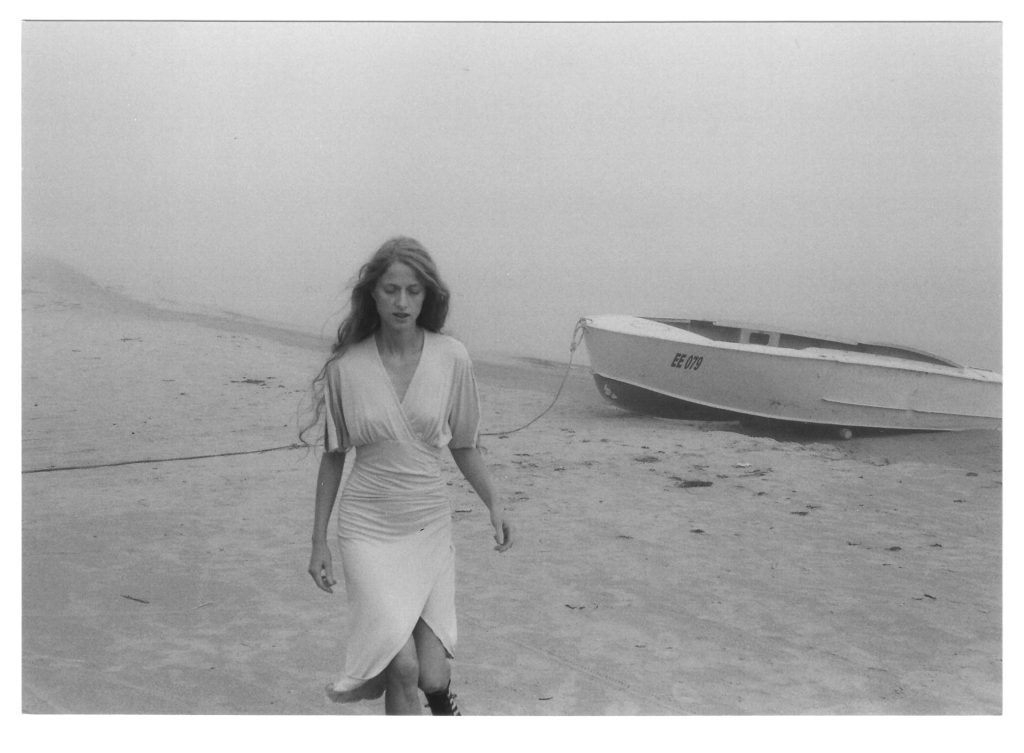
I visit the sea when I don’t have anything to do or just fancy a walk. I’ve had moments of walking up to the sea and deciding to touch it, but, most of the time, I don’t seek more contact than that because I like warm water. In summer, I like ponds where you can play around in the sludge.
When I was unemployed, I registered at the Jūrmala job centre because the lines were too long in Riga and it was more difficult to get there and find a place to park. Anyway, all that’s about the Gulf of Riga. The open sea is a different story. I love watching storms and often get my boots wet. Watching how the open sea clashes with the Gulf of Riga at Cape Kolka. I fill up on fresh air and love how the sky is different every time.
I’ve also been to the seaside – to Bolderāja – at times of feeling alone.
Friends who live by the sea usually only go down to it when someone’s visiting. Back in the day, I’d cycle to Jūrmala to meet friends.
Last autumn, I had the opportunity to make an old dream come true – to visit the Kolka lighthouse. I couldn’t have imagined it would smell so bad and that the foundations of the historical building would be in such a neglected state. One of the wooden buildings has burnt down because someone didn’t put out their fire after barbecuing.
I enjoy being by the sea with no one else around. Feeling that primitive, wild environment. It’s easier to catch that feeling of untouched nature in a bog though. I also like for a beach to be bordered by forest.
Elīna Kalniņa, historian
The sea to me means freedom – a sense of freedom. I go to the sea to rest, regain balance and sort myself out.
For Elīna, the book Vīri un kuģi (Men and Ships), a research project by Ieva Cimmermane, conjures associations with the sea. “It may not be art, but it’s about the art of living. The book touches on Latvians’ grit, opportunism, wisdom and strength. It’s about life by the sea, on the sea and with the sea. A fantastic read,” she says, and also recommends the work of the Lithuanian photographer Veronika Šleivytė.

Experiencing the Sea in Latvia
You can walk from the border of Lithuania up to the border of Estonia along the sea (with just a few diversions en route)! The 500-kilometre coastline is a designated hiking trail – the Jūrtaka. Split into daily sections, you can cover it all in one go or in multiple shorter trips.
It’s obviously also easy to travel by car or public transport. Some of my favourite places are the Ragaciems fish market, the Veczemju cliffs, Kaltenes kalvas, Pape, Cape Kolka and the Ainaži pier.
If you can’t or don’t want to travel, borrow a book from the fascinating Sea Library in Jūrmala, which delivers by post too!
More Latvian Songs About the Sea
A handful of classics, which are clearly still relevant today.
If you found this story interesting, you might want to continue with Tried & Tested Things to Do in Riga to Find Calm or Latvians and the Forest. Please also share it with friends!


